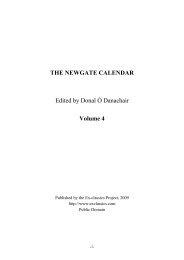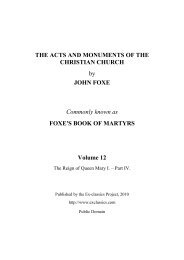PDF format (1.55 Mb) - The Ex-Classics Web Site
PDF format (1.55 Mb) - The Ex-Classics Web Site
PDF format (1.55 Mb) - The Ex-Classics Web Site
Create successful ePaper yourself
Turn your PDF publications into a flip-book with our unique Google optimized e-Paper software.
THE ANATOMY OF MELANCHOLY<br />
overtake a swift horseman, and by and by with as incredible celerity are supped up: which Lazius<br />
and Wernerus make an argument of the Argonauts sailing under ground. And that vast den or<br />
hole called Esmellen in Muscovia, quæ visitur horriendo hiatu, &c. which if anything casually<br />
fall in, makes such a roaring noise, that no thunder, or ordnance, or warlike engine can make the<br />
like; such another is Gilber's Cave in Lapland, with many the like. I would examine the Caspian<br />
Sea, and see where and how it exonerates itself, after it hath taken in Volga, Jaxares, Oxus, and<br />
those great rivers; at the mouth of Oby, or where? What vent the Mexican lake hath, the<br />
Titicacan in Peru, or that circular pool in the vale of Terapeia, of which Acosta l. 3. c. 16. hot in<br />
a cold country, the spring of which boils up in the middle twenty foot square, and hath no vent<br />
but exhalation: and that of Mare mortuum in Palestine, of Thrasymene, at Peruzium in Italy: the<br />
Mediterranean itself. For from the ocean, at the Straits of Gibraltar, there is a perpetual current<br />
into the Levant, and so likewise by the Thracian Bosphorus out of the Euxine or Black Sea,<br />
besides all those great rivers of Nile, Po, Rhone, &c. how is this water consumed, by the sun or<br />
otherwise? I would find out with Trajan the fountains of Danube, of Ganges, Oxus, see those<br />
Egyptian pyramids, Trajan's bridge, Grotto de Sybilla, Lucullus's fishponds, the temple of<br />
Nidrose, &c. (And, if I could, observe what becomes of swallows, storks, cranes, cuckoos,<br />
nightingales, redstarts, and many other kind of singing birds, water-fowls, hawks, &c. some of<br />
them are only seen in summer, some in winter; some are observed in the snow, and at no other<br />
times, each have their seasons. In winter not a bird is in Muscovy to be found, but at the spring in<br />
an instant the woods and hedges are full of them, saith Herbastein: how comes it to pass? Do<br />
they sleep in winter, like Gesner's Alpine mice; or do they lie hid (as Olaus affirms) "in the<br />
bottom of lakes and rivers, spiritum continentes? often so found by fishermen in Poland and<br />
Scandia, two together, mouth to mouth, wing to wing; and when the spring comes they revive<br />
again, or if they be brought into a stove, or to the fireside." Or do they follow the sun, as Peter<br />
Martyr legat Babylonica l. 2. manifestly convicts, out of his own knowledge; for when he was<br />
ambassador in Egypt, he saw swallows, Spanish kites, and many such other European birds, in<br />
December and January very familiarly flying, and in great abundance, about Alexandria, ubi<br />
floridæ tunc arbores ac viridaria. Or lie they hid in caves, rocks, and hollow trees, as most think,<br />
in deep tin-mines or sea-cliffs, as Mr. Carew gives out? I conclude of them all, for my part, as<br />
Munster doth of cranes and storks; whence they come, whither they go, incompertum adhuc, as<br />
yet we know not. We see them here, some in summer, some in winter; "their coming and going is<br />
sure in the night: in the plains of Asia" (saith he) "the storks meet on such a set day, he that<br />
comes last is torn in pieces, and so they get them gone." Many strange places, Isthmi, Euripi,<br />
Chersonesi, creeks, havens, promontories, straits, Lakes, baths, rocks, mountains, places, and<br />
fields, where cities have been ruined or swallowed, battles fought, creatures, sea-monsters,<br />
remora, &c. minerals, vegetals. Zoophytes were fit to be considered in such an expedition, and<br />
amongst the rest that of Harbastein his Tartar lamb, Hector Boethius goosebearing tree in the<br />
orchards, to which Cardan lib. 7. cap. 36. de rerum varietat. subscribes: Vertomannus wonderful<br />
palm, that fly in Hispaniola, that shines like a torch in the night, that one may well see to write;<br />
those spherical stones in Cuba which nature hath so made, and those like birds, beasts, fishes,<br />
crowns, swords, saws, pots, &c. usually found in the metal mines in Saxony about Mansfield,<br />
and in Poland near Nokow and Pallukie, as Munster and others relate. Many rare creatures and<br />
novelties each part of the world affords: amongst the rest, I would know for a certain whether<br />
-40
















